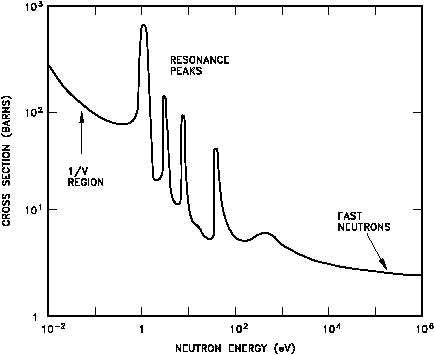DOE-HDBK-1019/1-93
Reactor Theory (Neutron Characteristics)
NUCLEAR CROSS SECTIONS AND NEUTRON FLUX
Rev. 0
Page 9
NP-02
Figure 1 Typical Neutron Absorption Cross Section vs. Neutron Energy
The variation of absorption cross sections with neutron energy is often complicated. For many
elements the absorption cross sections are small, ranging from a fraction of a barn to a few
barns for slow (or thermal) neutrons.
For a considerable number of nuclides of moderately high (or high) mass numbers, an
examination of the variation of the absorption cross section with the energy of the incident
neutron reveals the existence of three regions on a curve of absorption cross section versus
neutron energy. This cross section is illustrated in Figure 1. First, the cross section decreases
steadily with increasing neutron energy in a low energy region, which includes the thermal range
(E < 1 eV). In this region the absorption cross section, which is often high, is inversely
proportional to the velocity (v). This region is frequently referred to as the "1/v region,"
because the absorption cross section is proportional to 1/v, which is the reciprocal of neutron
velocity. Following the 1/v region, there occurs the "resonance region" in which the cross
sections rise sharply to high values called "resonance peaks" for neutrons of certain energies,
and then fall again. These energies are called resonance energies and are a result of the affinity
of the nucleus for neutrons whose energies closely match its discrete, quantum energy levels.
That is, when the binding energy of a neutron plus the kinetic energy of the neutron are exactly
equal to the amount required to raise a compound nucleus from its ground state to a quantum
level, resonance absorption occurs. The following example problem further illustrates this point.

